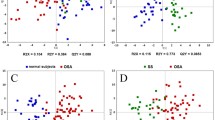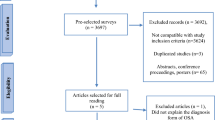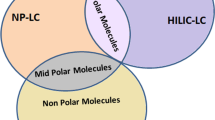Abstract
Introduction
Obstructive sleep apnea (OSA) is very common sleep problem, and it is associated with serious morbidities such as cardiovascular diseases and metabolic diseases. Overnight polysomnography (PSG) is the gold standard test for OSA, but it is expensive and requires specific facilities and equipment. Thus, novel screening methods are needed for effective diagnosis and follow-up in OSA.
Objectives
The aims of the study were to investigate the urinary metabolic signatures and identify potential urine markers for OSA using a mass spectrometry (MS)-based assay for targeted metabolomics.
Methods
Urine samples were collected from 48 male subjects who visited a sleep clinic for suspicious OSA. All underwent overnight in-laboratory polysomnography. The Biocrates AbsoluteIDQ p180 kit was used for targeted metabolomics.
Results
Among the 86 metabolites quantified, three acylcarnitines, one biogenic amine, two glycerophospholipids, and two sphingomyelins were differently expressed in OSA patients [apnea-hypopnea index (AHI) ≥5] compared with control groups (AHI <5 and/or simple snoring with no other sleep disorders). Additional partial correlation and multivariate logistic regression analysis revealed that long-chain acylcarnitine C14:1, symmetric dimethylarginine, and sphingomyelin C18:1 might be potential biomarkers for OSA. Receiver operating characteristic analysis showed favorable predictive properties of these metabolites. Furthermore, a combination of the metabolites exceeding cutoff values yielded further improved sensitivity or specificity.
Conclusions
MS-based targeted metabolomics identified specific classes of urinary metabolites that were up-regulated in OSA patients. Further assessments in large populations are required to clarify the screening values of these metabolite markers.


Similar content being viewed by others
References
Adams, S. H., Hoppel, C. L., Lok, K. H., Zhao, L., Wong, S. W., Minkler, P. E., et al. (2009). Plasma acylcarnitine profiles suggest incomplete long-chain fatty acid beta-oxidation and altered tricarboxylic acid cycle activity in type 2 diabetic African-American women. The Journal of nutrition, 139(6), 1073–1081. doi:10.3945/jn.108.103754.
Aguer, C., McCoin, C. S., Knotts, T. A., Thrush, A. B., Ono-Moore, K., McPherson, R., et al. (2015). Acylcarnitines: potential implications for skeletal muscle insulin resistance. The FASEB Journal: Official Publication of the Federation of American Societies for Experimental Biology, 29(1), 336–345. doi:10.1096/fj.14-255901.
Bouatra, S., Aziat, F., Mandal, R., Guo, A. C., Wilson, M. R., Knox, C., et al. (2013). Thue human urine metabolome. PLoS ONE, 8(9), e73076. doi:10.1374/jn.pone.0073076.
Bruder, E. D., & Raff, H. (2010). Cardiac and plasma lipid profiles in response to acute hypoxia in neonatal and young adult rats. Lipids in Health and Disease, 9, 3. doi:10.1186/1476-511x-9-3.
Davies, S. K., Ang, J. E., Revell, V. L., Holmes, B., Mann, A., Robertson, F. P., et al. (2014). Effect of sleep deprivation on the human metabolome. Proceedings of the National Academy of Sciences of the United States of America, 111(29), 10761–10766. doi:10.1073/pnas.1402663111.
De Luca Canto, G., Pacheco-Pereira, C., Aydinoz, S., Major, P. W., Flores-Mir, C., & Gozal, D. (2015). Biomarkers associated with obstructive sleep apnea and morbidities: A scoping review. Sleep Medicine, 16(3), 347–357. doi:10.1016/j.sleep.2014.12.007.
Hanamatsu, H., Ohnishi, S., Sakai, S., Yuyama, K., Mitsutake, S., Takeda, H., et al. (2014). Altered levels of serum sphingomyelin and ceramide containing distinct acyl chains in young obese adults. Nutrition Diabetes, 4, e141. doi:10.1038/nutd.2014.38.
Iber, C., Ancoli-Israel, S., Chesson, A. L., & Quan, S. F. (2007). The AASM manual for the scoring of sleep and associated events: rules, terminology, and technical specifications (1st edn.). Westchester, IL: American Academy of Sleep Medicine.
Ip, M. S., Lam, B., Chan, L. Y., Zheng, L., Tsang, K. W., Fung, P. C., et al. (2000). Circulating nitric oxide is suppressed in obstructive sleep apnea and is reversed by nasal continuous positive airway pressure. American Journal of Respiratory and Critical Care Medicine, 162(6), 2166–2171. doi:10.1164/ajrccm.162.6.2002126.
Jiang, X. C., Paultre, F., Pearson, T. A., Reed, R. G., Francis, C. K., Lin, M., et al. (2000). Plasma sphingomyelin level as a risk factor for coronary artery disease. ArterioSclerosis, Thrombosis, and Vascular Biology, 20(12), 2614–2618.
Kim, J., Hakim, F., Kheirandish-Gozal, L., & Gozal, D. (2011). Inflammatory pathways in children with insufficient or disordered sleep. Respiratory Physiology & Neurobiology, 178(3), 465–474. doi:10.1016/j.resp.2011.04.024.
Kinnunen, P. K., & Holopainen, J. M. (2002). Sphingomyelinase activity of LDL: A link between atherosclerosis, ceramide, and apoptosis? Trends in Cardiovascular Medicine, 12(1), 37–42.
Koves, T. R., Li, P., An, J., Akimoto, T., Slentz, D., Ilkayeva, O., et al. (2005). Peroxisome proliferator-activated receptor-gamma co-activator 1alpha-mediated metabolic remodeling of skeletal myocytes mimics exercise training and reverses lipid-induced mitochondrial inefficiency. The Journal of Biological Chemistry, 280(39), 33588–33598. doi:10.1074/jbc.M507621200.
Lou, B. S., Wu, P. S., Liu, Y., & Wang, J. S. (2014). Effects of acute systematic hypoxia on human urinary metabolites using LC-MS-based metabolomics. High Altitude Medicine & Biology, 15(2), 192–202, doi:10.1089/ham.2013.1130.
Lu, T. M., Chung, M. Y., Lin, C. C., Hsu, C. P., & Lin, S. J. (2011). Asymmetric dimethylarginine and clinical outcomes in chronic kidney disease. Clinical Journal of the American Society of Nephrology, 6(7), 1566–1572. doi:10.2215/cjn.08490910.
Madsen, R., Lundstedt, T., & Trygg, J. (2010). Chemometrics in metabolomics–a review in human disease diagnosis. Analytica Chimica Acta, 659(1–2), 23–33. doi:10.1016/j.aca.2009.11.042.
Mai, M., Tonjes, A., Kovacs, P., Stumvoll, M., Fiedler, G. M., & Leichtle, A. B. (2013). Serum levels of acylcarnitines are altered in prediabetic conditions. PLoS ONE, 8(12), e82459. doi:10.1371/journal.pone.0082459.
Otusbo, C., Bharathi, S., Uppala, R., Ilkayeva, O. R., Wang, D., McHugh, K., et al. (2015). Long-chain acylcarnitines reduce lung function by inhibiting pulmonary surfactant. The Journal of Biological Chemistry, 290(39), 23897–23904. doi:10.1074/jbc.M115.655837.
Roberts, L. D., Souza, A. L., Gerszten, R. E., & Clish, C. B. (2012). Targeted metabolomics. Current Protocols in Molecular Biology. doi:10.1002/0471142727.mb3002s98. Chapter 30, Unit 30.32.31–24.
Romisch-Margel, W., Prehn, C., Bogumil, R., Rohring, C., Suhre, K., & Adamsk, J. (2012). Procedure for tissue sample preparation and metabolite extraction for high-throughput targeted metabolomics. Metabolomics, 8, 133–142. doi:10.1007/s11306-011-0293-4.
Rutkowsky, J. M., Knotts, T. A., Ono-Moore, K. D., McCoin, C. S., Huang, S., Schneider, D., et al. (2014). Acylcarnitines activate proinflammatory signaling pathways. American Journal of Physiology. Endocrinology and Metabolism, 306(12), E1378–E1387. doi:10.1152/ajpendo.00656.2013.
Schlitt, A., Blankenberg, S., Yan, D., von Gizycki, H., Buerke, M., Werdan, K., et al. (2006). Further evaluation of plasma sphingomyelin levels as a risk factor for coronary artery disease. Nutrition & Metabolism, 3, 5. doi:10.1186/1743-7075-3-5.
Schulz, R., Schmidt, D., Blum, A., Lopes-Ribeiro, X., Lucke, C., Mayer, K., et al. (2000). Decreased plasma levels of nitric oxide derivatives in obstructive sleep apnoea: Response to CPAP therapy. Thorax, 55(12), 1046–1051.
Schwedhelm, E., Wallaschofski, H., Atzler, D., Dorr, M., Nauck, M., Volker, U., et al. (2014). Incidence of all-cause and cardiovascular mortality predicted by symmetric dimethylarginine in the population-based study of health in pomerania. PLoS ONE, 9(5), e96875. doi:10.1371/journal.pone.0096875.
Strobel, J., Mieth, M., Endress, B., Auge, D., Konig, J., Fromm, M. F., et al. (2012). Interaction of the cardiovascular risk marker asymmetric dimethylarginine (ADMA) with the human cationic amino acid transporter 1 (CAT1). Journal of Molecular and Cellular Cardiology, 53(3), 392–400. doi:10.1016/j.yjmcc.2012.06.002.
Tai, E. S., Tan, M. L., Stevens, R. D., Low, Y. L., Muehlbauer, M. J., Goh, D. L., et al. (2010). Insulin resistance is associated with a metabolic profile of altered protein metabolism in Chinese and Asian-Indian men. Diabetologia, 53(4), 757–767. doi:10.1007/s00125-009-1637-8.
Vinayavekhin, N., & Saghatelian, A. (2010). Untargeted metabolomics. Current Protocols in Molecular Biology. doi:10.1002/0471142727.mb3001s90. Chapter 30, Unit 30.31.31–24.
Xia, J., Sinelnikov, I. V., Han, B., & Wishart, D. S. (2015). MetaboAnalyst 3.0-making metabolomics more meaningful. Nucleic Acids Research, 43(W1), W251–7, doi:10.1093/nar/gkv380.
Yamagishi, K., Ohira, T., Nakano, H., Bielinski, S. J., Sakurai, S., Imano, H., et al. (2010). Cross-cultural comparison of the sleep-disordered breathing prevalence among Americans and Japanese. The European Respiratory Journal: Official Journal of the European Society for Clinical Respiratory Physiology, 36(2), 379–384. doi:10.1183/09031936.00118609.
Young, T., Palta, M., Dempsey, J., Skatrud, J., Weber, S., & Badr, S. (1993). The occurrence of sleep-disordered breathing among middle-aged adults. The New England Journal of Medicine, 328(17), 1230–1235. doi:10.1056/nejm199304293281704.
Zheng, W., Kollmeyer, J., Symolon, H., Momin, A., Munter, E., Wang, E., et al. (2006). Ceramides and other bioactive sphingolipid backbones in health and disease: lipidomic analysis, metabolism and roles in membrane structure, dynamics, signaling and autophagy. Biochimica et Biophysica Acta, 1758(12), 1864–1884. doi:10.1016/j.bbamem.2006.08.009.
Acknowledgements
The English in this document has been checked by at least two professional editors, both native speakers of English. For a certificate, please see: http://www.textcheck.com/certificate/SPbO3y.
Authors contributions
KC, J-WP, C-SR, and H-WS participated in study conception and design. I-HH, C-SR, and H-WS supported the clinical study and sample collection. ML and DS supported sample management and clinical data acquisition. KC, J-YC, DWY, and H-WS participated in the acquisition of data and interpretation of results from the metabolomic analysis. KC and DWY drafted the article, and all authors reviewed and revised the manuscript.
Funding
This work was supported by a grant from the Korean Health Technology R&D Project, Ministry of Health and Welfare, Republic of Korea (HI15C2310) and by a National Research Foundation of Korea grant funded by the Korea government (MEST) (NRF-2014R1A2A2A01005541). D.W.Y. received a scholarship from the BK21-plus education program provided by the National Research Foundation of Korea.
Author information
Authors and Affiliations
Corresponding authors
Ethics declarations
Conflict of interest
The authors declare that they have no conflict of interest with the contents of this article.
Ethical Approval
All procedures performed in studies involving human participants were in accordance with the ethical standards of the institutional and/or national research committee and with the 1964 Helsinki Declaration. The Institutional Review Board at Seoul National University Hospital reviewed and approved the study protocol.
Informed Consent
Informed consent for the use of specimens was obtained from all individual participants included in the study.
Additional information
Kumsun Cho and Dae Wui Yoon have contributed equally to this work.
Electronic supplementary material
Below is the link to the electronic supplementary material.
11306_2017_1216_MOESM1_ESM.tif
Supplementary Figure 1—Comparison of hexoses levels according to OSA severity. All levels were corrected with corresponding urinary creatinine concentrations. Data are represented as mean ± SD (TIF 242 KB)
11306_2017_1216_MOESM2_ESM.tif
Supplementary Figure 2—Multivariate analysis between control and OSA groups. A, principal component analysis (PCA) plot; B, partial least squares discriminant analysis (PLS-DA) plot highlight the separation between controls (green) and OSA patients (red); C, variable importance in projection (VIP) plot. The most discriminating metabolites are shown in descending order of importance. The color boxes indicate whether metabolite concentration is increased (red) or decreased (green) in OSA vs. controls (TIF 766 KB)
11306_2017_1216_MOESM3_ESM.tif
Supplementary Figure 3—Identification of metabolites with significant changes in expression by significance analysis of microarray (SAM). A, the relation between delta and false discovery rate (FDR) (left), and delta and the number of significant metabolites (right). B, resultant metabolites from SAM with a delta value of 0.8. The significant variables are highlighted in green (TIF 643 KB)
Rights and permissions
About this article
Cite this article
Cho, K., Yoon, D.W., Lee, M. et al. Urinary Metabolomic Signatures in Obstructive Sleep Apnea through Targeted Metabolomic Analysis: A Pilot Study. Metabolomics 13, 88 (2017). https://doi.org/10.1007/s11306-017-1216-9
Received:
Accepted:
Published:
DOI: https://doi.org/10.1007/s11306-017-1216-9




